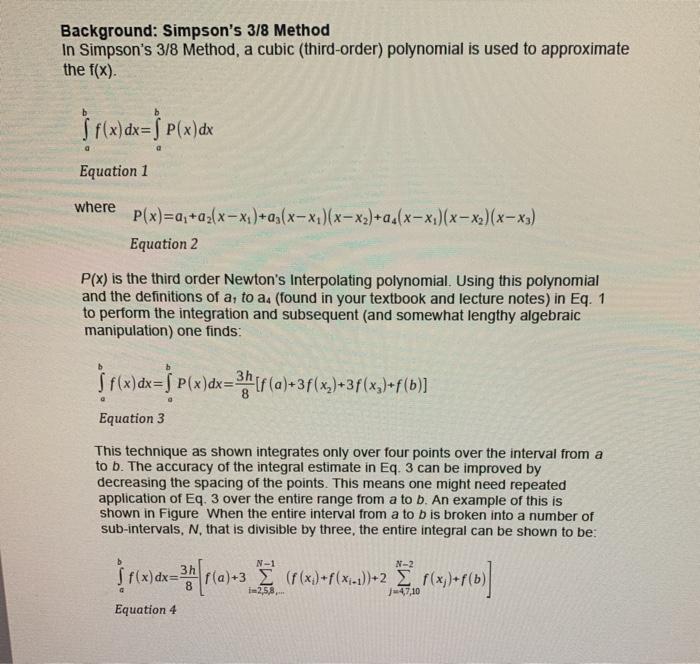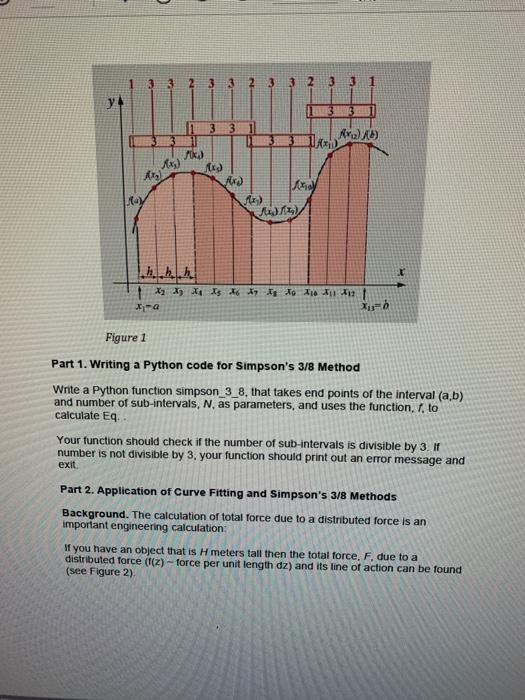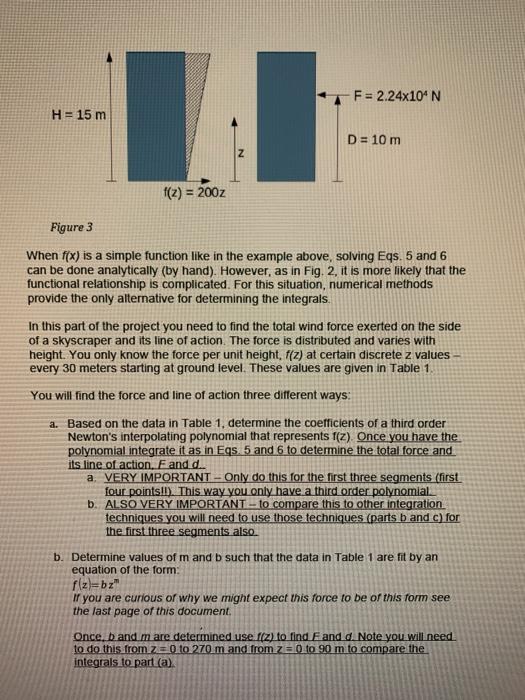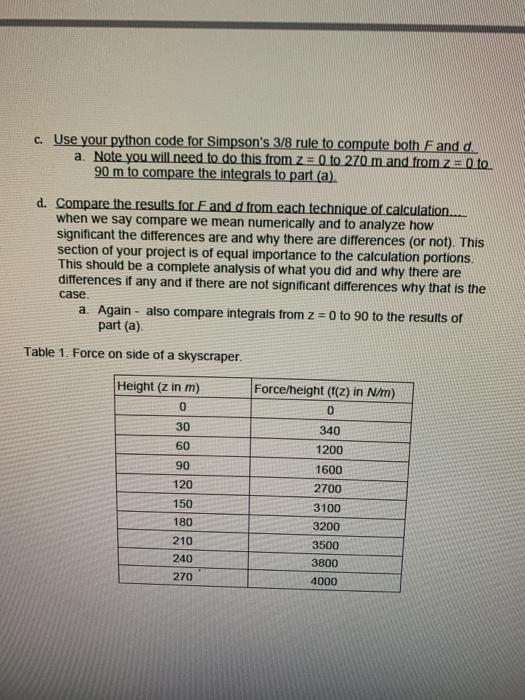Background: Simpson's 3/8 Method In Simpson's 3/8 Method, a cubic (third-order) polynomial is used to approximate the f(x) p(x)dx=P[x]dx Equation 1 where P(x)=x; +2(x-x)+43(x-x1)(x-x2)+a_{x-x)(x - x)(x-x) Equation 2 P(x) is the third order Newton's Interpolating polynomial. Using this polynomial and the definitions of a, to a: (found in your textbook and lecture notes) in Eq. 1 to perform the integration and subsequent (and somewhat lengthy algebraic manipulation) one finds: 5 f(x)dx=P(x)dx=3h (r(a)+3f(x)+3f(x)=f(b)] Equation 3 This technique as shown integrates only over four points over the interval from a to b. The accuracy of the integral estimate in Eq. 3 can be improved by decreasing the spacing of the points. This means one might need repeated application of Eq. 3 over the entire range from a to b. An example of this is shown in Figure When the entire interval from a to b is broken into a number of sub-intervals, N, that is divisible by three, the entire integral can be shown to be: pla)dx==3(7105-3 (r(x)=f(x.)2 r(x)=(o)] Equation 4 3 3 2 3 3 1 y 3 Ava) 1 fik 3 AN ROV 1 X 2 X X X6 17 de No Altun a Xu- Figure 1 Part 1. Writing a Python code for Simpson's 3/8 Method Write a Python function simpson_3_8, that takes end points of the interval (a,b) and number of sub-intervals, N. as parameters, and uses the function. 1. to calculate Eq. Your function should check if the number of sub-intervals is divisible by 3. If number is not divisible by 3, your function should print out an error message and exit Part 2. Application of Curve Fitting and Simpson's 3/8 Methods Background. The calculation of total force due to a distributed force is an important engineering calculation: If you have an object that is H meters tall then the total force. F. due to a distributed force ((z) - force per unit length dz) and its line of action can be found (see Figure 2) 78.8% 1 (7 Figure 2 internship The total force due to the distributed force is F-I field Equation 5 The location of the line of action, d, of Fis the effective location of the force F. rzdz Equation 6 For example, if f(z)=2002 [N/m] with z ranging from 0 to 15 m. 15m FE 200 z dz 2= 100225*100 (152-0)=2.25 x 10*N The line of action would be: 15 d 1 2f1z|de Sflzldz 2.25x10y 2.25 x 10*N 200 zdz 1 200 2.25x 10' N 3 (15-0) 10m F = 2.24x10^N H = 15 m 1 D = 10 m Z f(z) = 2002 Figure 3 When f(x) is a simple function like in the example above, solving Eqs. 5 and 6 can be done analytically (by hand). However, as in Fig. 2, it is more likely that the functional relationship is complicated. For this situation, numerical methods provide the only alternative for determining the integrals In this part of the project you need to find the total wind force exerted on the side of a skyscraper and its line of action. The force is distributed and varies with height. You only know the force per unit height, f(z) at certain discrete z values every 30 meters starting at ground level. These values are given in Table 1. You will find the force and line of action three different ways: a. Based on the data in Table 1, determine the coefficients of a third order Newton's interpolating polynomial that represents f(z) Once you have the polynomial integrate it as in Egs. 5 and 6 to determine the total force and its line of action. F and d. a VERY IMPORTANT - Only do this for the first three segments (first four pointsli). This way you only have a third order polynomial b. ALSO VERY IMPORTANT - to compare this to other integration techniques you will need to use those techniques (parts b and c) for the first three segments also. b. Determine values of m and b such that the data in Table 1 are fit by an equation of the form: f(z)=bz" If you are curious of why we might expect this force to be of this form see the last page of this document Once, b and m are determined useftz) to find F and d. Note you will need to do this from z = 0 to 270 m and from z = 0 to 90 m to compare the integrals to part (a). c. Use your python code for Simpson's 3/8 rule to compute both Fand d a. Note you will need to do this from z = 0 to 270 m and from z = 0 to. 90 m to compare the integrals to part (a). d. Compare the results for Fand d from each technique of calculation... when we say compare we mean numerically and to analyze how significant the differences are and why there are differences (or not). This section of your project is of equal importance to the calculation portions. This should be a complete analysis of what you did and why there are differences if any and if there are not significant differences why that is the case. a. Again - also compare integrals from z = 0 to 90 to the results of part (a). Table 1. Force on side of a skyscraper. Height (z in m) 0 30 60 Force/height (f(z) in N/m) 0 340 1200 1600 2700 3100 90 120 150 3200 180 210 240 3500 3800 270 4000 Background: Simpson's 3/8 Method In Simpson's 3/8 Method, a cubic (third-order) polynomial is used to approximate the f(x) p(x)dx=P[x]dx Equation 1 where P(x)=x; +2(x-x)+43(x-x1)(x-x2)+a_{x-x)(x - x)(x-x) Equation 2 P(x) is the third order Newton's Interpolating polynomial. Using this polynomial and the definitions of a, to a: (found in your textbook and lecture notes) in Eq. 1 to perform the integration and subsequent (and somewhat lengthy algebraic manipulation) one finds: 5 f(x)dx=P(x)dx=3h (r(a)+3f(x)+3f(x)=f(b)] Equation 3 This technique as shown integrates only over four points over the interval from a to b. The accuracy of the integral estimate in Eq. 3 can be improved by decreasing the spacing of the points. This means one might need repeated application of Eq. 3 over the entire range from a to b. An example of this is shown in Figure When the entire interval from a to b is broken into a number of sub-intervals, N, that is divisible by three, the entire integral can be shown to be: pla)dx==3(7105-3 (r(x)=f(x.)2 r(x)=(o)] Equation 4 3 3 2 3 3 1 y 3 Ava) 1 fik 3 AN ROV 1 X 2 X X X6 17 de No Altun a Xu- Figure 1 Part 1. Writing a Python code for Simpson's 3/8 Method Write a Python function simpson_3_8, that takes end points of the interval (a,b) and number of sub-intervals, N. as parameters, and uses the function. 1. to calculate Eq. Your function should check if the number of sub-intervals is divisible by 3. If number is not divisible by 3, your function should print out an error message and exit Part 2. Application of Curve Fitting and Simpson's 3/8 Methods Background. The calculation of total force due to a distributed force is an important engineering calculation: If you have an object that is H meters tall then the total force. F. due to a distributed force ((z) - force per unit length dz) and its line of action can be found (see Figure 2) 78.8% 1 (7 Figure 2 internship The total force due to the distributed force is F-I field Equation 5 The location of the line of action, d, of Fis the effective location of the force F. rzdz Equation 6 For example, if f(z)=2002 [N/m] with z ranging from 0 to 15 m. 15m FE 200 z dz 2= 100225*100 (152-0)=2.25 x 10*N The line of action would be: 15 d 1 2f1z|de Sflzldz 2.25x10y 2.25 x 10*N 200 zdz 1 200 2.25x 10' N 3 (15-0) 10m F = 2.24x10^N H = 15 m 1 D = 10 m Z f(z) = 2002 Figure 3 When f(x) is a simple function like in the example above, solving Eqs. 5 and 6 can be done analytically (by hand). However, as in Fig. 2, it is more likely that the functional relationship is complicated. For this situation, numerical methods provide the only alternative for determining the integrals In this part of the project you need to find the total wind force exerted on the side of a skyscraper and its line of action. The force is distributed and varies with height. You only know the force per unit height, f(z) at certain discrete z values every 30 meters starting at ground level. These values are given in Table 1. You will find the force and line of action three different ways: a. Based on the data in Table 1, determine the coefficients of a third order Newton's interpolating polynomial that represents f(z) Once you have the polynomial integrate it as in Egs. 5 and 6 to determine the total force and its line of action. F and d. a VERY IMPORTANT - Only do this for the first three segments (first four pointsli). This way you only have a third order polynomial b. ALSO VERY IMPORTANT - to compare this to other integration techniques you will need to use those techniques (parts b and c) for the first three segments also. b. Determine values of m and b such that the data in Table 1 are fit by an equation of the form: f(z)=bz" If you are curious of why we might expect this force to be of this form see the last page of this document Once, b and m are determined useftz) to find F and d. Note you will need to do this from z = 0 to 270 m and from z = 0 to 90 m to compare the integrals to part (a). c. Use your python code for Simpson's 3/8 rule to compute both Fand d a. Note you will need to do this from z = 0 to 270 m and from z = 0 to. 90 m to compare the integrals to part (a). d. Compare the results for Fand d from each technique of calculation... when we say compare we mean numerically and to analyze how significant the differences are and why there are differences (or not). This section of your project is of equal importance to the calculation portions. This should be a complete analysis of what you did and why there are differences if any and if there are not significant differences why that is the case. a. Again - also compare integrals from z = 0 to 90 to the results of part (a). Table 1. Force on side of a skyscraper. Height (z in m) 0 30 60 Force/height (f(z) in N/m) 0 340 1200 1600 2700 3100 90 120 150 3200 180 210 240 3500 3800 270 4000











